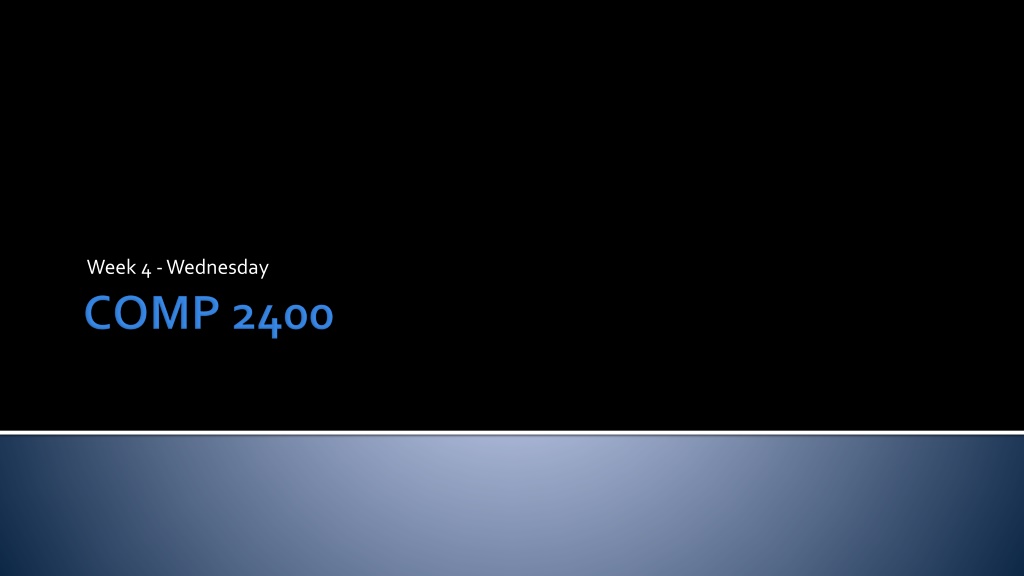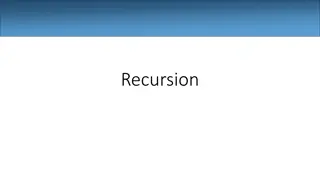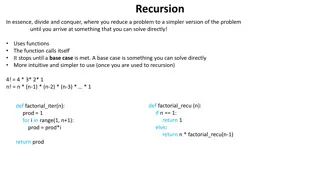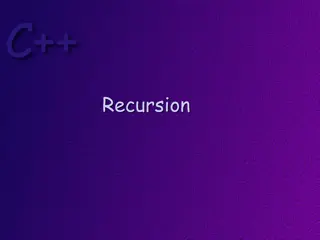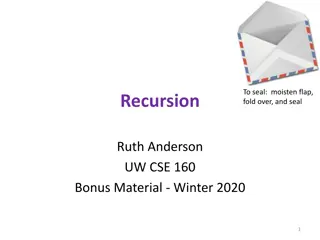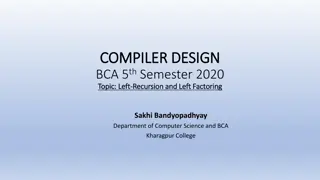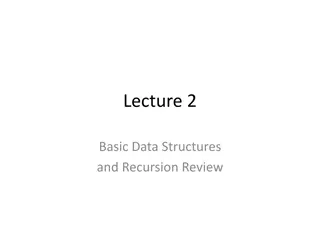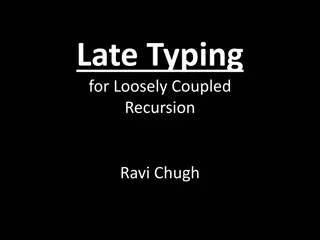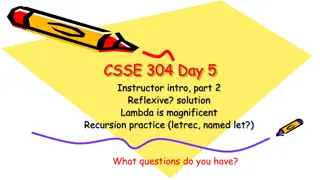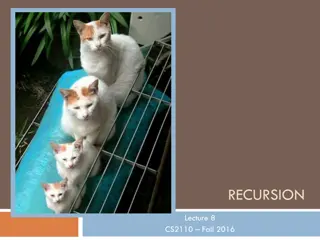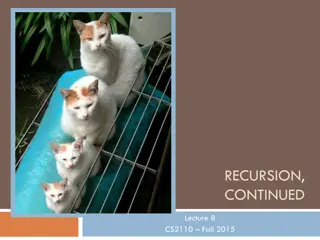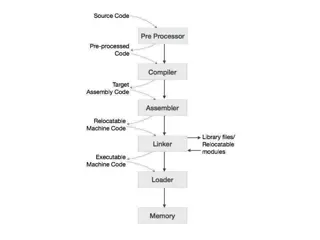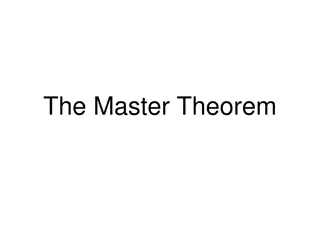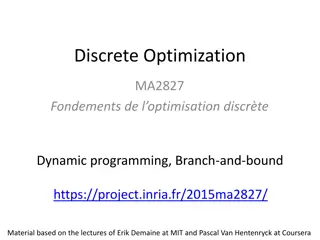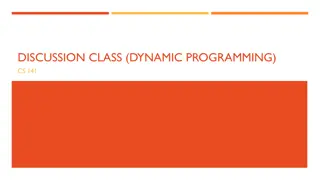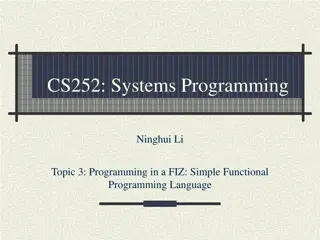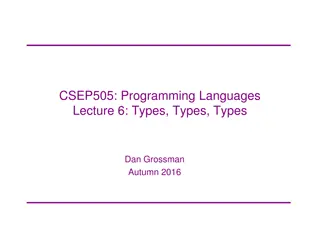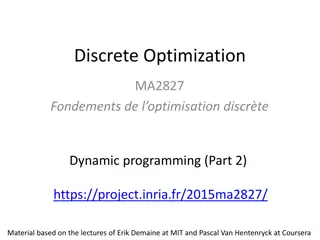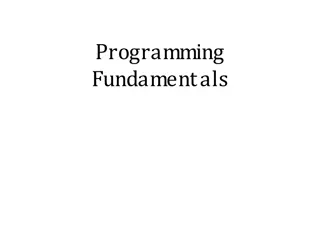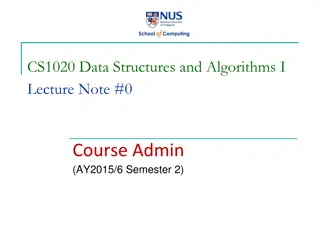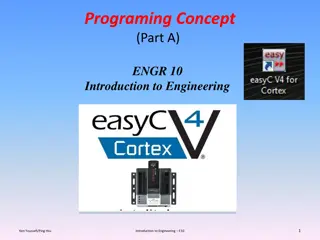Understanding Recursion in Programming
An exploration of recursion in programming, focusing on the concept of defining something in terms of itself, the importance of base and recursive cases, and the top-down approach to problem-solving. Examples include the factorial function and walking to a door using recursion-based steps.
Download Presentation

Please find below an Image/Link to download the presentation.
The content on the website is provided AS IS for your information and personal use only. It may not be sold, licensed, or shared on other websites without obtaining consent from the author. Download presentation by click this link. If you encounter any issues during the download, it is possible that the publisher has removed the file from their server.
E N D
Presentation Transcript
What did we talk about last time? Functions
Unix never says "please." Rob Pike It also never says: "Thank you" "You're welcome" "I'm sorry" "Are you sure you want to do that?"
Defining something in terms of itself To be useful, the definition must be based on progressively simpler definitions of the thing being defined If a function calls itself (directly or indirectly), it's recursive
Explicitly: n! = (n)(n 1)(n 2) (2)(1) Recursively: n! = (n)(n 1)! 1! = 1 6! = 6 5! 5! = 5 4! 4! = 4 3! 3! = 3 2! 2! = 2 1! 1! = 1 6! = 6 5 4 3 2 1 = 720
Two parts: Base case(s) Tells recursion when to stop For factorial, n = 1 or n = 0 are examples of base cases Recursive case(s) Allows recursion to progress "Leap of faith" For factorial, n > 1 is the recursive case
Top down approach Don't try to solve the whole problem Deal with the next step in the problem Then make the "leap of faith" Assume that you can solve any smaller part of the problem
Problem: You want to walk to the door Base case (if you reach the door): You're done! Recursive case (if you aren't there yet): Take a step toward the door Problem Problem Problem Problem Problem
Base case (n 1): 1! = 0! = 1 Recursive case (n > 1): n! = n(n 1)!
long long factorial (int n) { if (n <= 1) return 1; else return n*factorial (n 1); } Base Case Recursive Case
Given an integer, count the number of zeroes in its representation Example: 13007804 3 zeroes
Base cases (number less than 10): 1 zero if it is 0 No zeroes otherwise Recursive cases (number greater than or equal to 10): One more zero than the rest of the number if the last digit is 0 The same number of zeroes as the rest of the number if the last digit is not 0
int zeroes (int n) { if (n == 0) return 1; else if (n < 10) return 0; else if (n % 10 == 0) return 1 + zeroes (n / 10); else return zeroes (n / 10); } Base Cases Recursive Cases
Given an array of integers in (ascending) sorted order, find the index of the one you are looking for Useful problem with practical applications Recursion makes an efficient solution obvious Play the High-Low game
Base cases: The number isn't in the range you are looking at. Return -1. The number in the middle of the range is the one you are looking for. Return its index. Recursion cases: The number in the middle of the range is too low. Look in the range above it. The number in middle of the range is too high. Look in the range below it.
int search (int array[], int n, int start, int end) { int midpoint = (start + end)/2; if (start >= end) return -1; else if (array[midpoint] == n ) return midpoint; else if (array[midpoint] < n) return search (array, n, midpoint + 1, end); else return search (array, n, start, midpoint); } Base Cases Recursive Cases
Write a recursive function to determine the number of digits in a number
Is there a problem with calling a function from the same function? How does the computer keep track of which function is which?
A stack is a FILO data structure used to store and retrieve items in a particular order Just like a stack of blocks: Push Push Pop
In the same way, the local variables for each function are stored on the call stack When a function is called, a copy of that function is pushed onto the stack When a function returns, that copy of the function pops off the stack Call Return Call factorial solve solve solve main main main main
Each copy of factorial has a value of n stored as a local variable For 6! : factorial(1) 1 1 2*factorial(1) factorial(2) 2 3*factorial(2) factorial(3) 6 4*factorial(3) factorial(4) 24 5*factorial(4) factorial(5) 120 6*factorial(5) factorial(6) 720 x = factorial(6);
Calling functions has overhead, so calling a function 1,000 times is usually much slower than running equivalent code in a loop 1,000 times Modern compilers, however, are relatively good at optimizing recursive calls Some of the most commonly used recursive algorithms (binary search and binary search tree manipulation) run in O(log n) The overhead is less noticeable since the function isn't called many times People looking for serious performance tuning will usually convert those algorithms to iterative implementations
The segment of memory dedicated to the stack is limited in size Too many recursive calls will overflow the stack Even if your program would get the right answer with an unlimited stack, it will crash after what's usually tens of thousands of calls Be careful when writing recursion that might go thousands deep Another reason to stick to O(log n) algorithms
The following recursive function adds the number from 1 up to n It follows almost the same shape as factorial() long sumUpTo(int n) { if (n == 1) else } return 1; return n + sumUpTo(n - 1); The sumUpTo() function works just fine for values like 100 It will get a stack overflow on values like 500000
Scope Processes
Office hours are canceled today Read LPI chapter 6 Finish Project 2 Due Friday by midnight!
